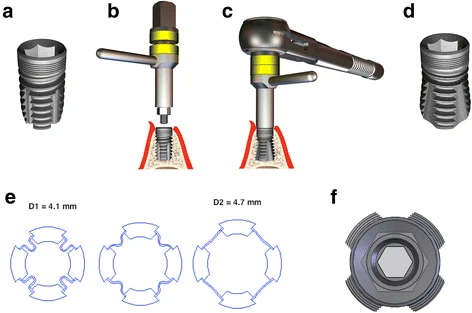Figure 1. a Closed short expandable dental implant (4.1 × 7 mm). The implant-abutment connection is characterised by an internal hexagon for rotation stability, combining the advantages of conical and parallel surfaces to reduce microgaps and micromovement. The microthread concept and platform switching concept are implemented in the implant shoulder to reduce periimplant bone strain. b Manual fixation of the expansion tool. Take note of the distance between both yellow rings. c Completion of the expansion process using the ratchet. Take note of the contact between both yellow rings. d Opened short expandable dental implant (4.1 × 7 mm). The expanded implant provides an increased bone-to-implant interface (pyramid shape) in the apical portion. e Cross-section view of the implant apex. The apical expansion process is characterised by the unfolding of four wings, which are connected by four foils. D1: diameter of the closed implant. D2: diameter of the opened implant. f Top view of the expanded implant. The expanded implant (4.1-mm diameter) displays an apical diameter of 4.7 mm and length of the edge (base) of 4.4 mm
Figure 1. a Closed short expandable dental implant
author: Waldemar Reich,Ramona Schweyen,Christian Heinzelmann,Jeremias Hey,Bilal Al-Nawas, Alexander Walter Eckert | publisher: drg. Andreas Tjandra, Sp. Perio, FISID

Serial posts:
- Novel expandable short dental implants with reduced vertical bone height
- Introduction : Novel expandable short dental implants (1)
- Introduction : Novel expandable short dental implants (2)
- Material & methods : Novel expandable short dental implants (1)
- Material & methods : Novel expandable short dental implants (2)
- Results : Novel expandable short dental implants (2)
- Discussion : Novel expandable short dental implants (1)
- Discussion : Novel expandable short dental implants (2)
- Discussion : Novel expandable short dental implants (3)
- Discussion : Novel expandable short dental implants (4)
- Discussion : Novel expandable short dental implants (5)
- Table 1 Patient recruitment
- Table 2 Surgical treatment protocol
- Table 3 Prosthetic treatment protocol
- Table 4 Clinical characteristics of the study cohort
- Figure 1. a Closed short expandable dental implant
- Figure 2. Cumulative implant survival over the follow-up period
- Figure 3. a Primary implant stability
- Figure 4 a–h Prosthetic restauration—follow-up examination. Intraoral and perioral views of a rehabilitated female patient. (She asked explicitly only for implantological treatment in the mandible.)
- Figure 5 Postoperative orthopantomogram